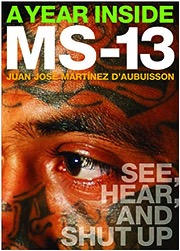SWJ El Centro Book Review – A Year Inside MS-13: See Hear, and Shut Up

SWJ El Centro Book Review – A Year Inside MS-13: See, Hear, and Shut Up
Angelo J. Thomas

Juan Jose Martínez D’Aubuisson, See, Hear, and Shut Up: A Year Inside MS-13. New York: OR Books, 2019 [ISBN: 9781949017151, Paperback, 128 Pages]
See, Hear, and Shut Up is the product of Juan Jose Martínez’s one year stay in 2011 with the Guanacos Criminales Salvatrucha (GCS)—a Mara Salvatrucha (MS-13) clica (clique)—in the suburbs of San Salvador. Translated from Spanish, the book provides an inside perspective on MS-13 which unfolds through the telling of highly detailed vignettes. Reading more like a cohesive and gripping short story than an academic monograph, in just over 100 pages the book brings to life both MS-13’s humanity and intense cruelty. Martínez is embedded with GCS as their leadership changes and ramps up to continue a generational war against their hated enemy and approximate mirror image, the Sycos del Barrio 18 clica which dominates the bottom area of the hill they claim as their own. The detail and interpersonal relationships concerning MS-13 which Martínez is able to recount make this work inescapably real and riveting.
Martínez, a socio-cultural anthropologist who has studied gangs for decades, was able to embed himself with MS-13 with the help of a local priest. The youth center where he first meets the gang’s leadership is little more than an operational base for the gang, who use it as their HQ in order to control their local hill-top turf. The prologue, written by Martínez’s brother—with whom he co-authored the MS-13 focused work The Hollywood Kid (Verso 2019)—is a testament to his credibility and dedication to understanding MS-13. The introduction to the work is a concise and useful history of MS-13 which makes an already accessible book understandable to those with no prior knowledge of MS. The next 22 chapters are short vignettes of Martínez’s interactions with the gang. He watches them conduct business, share meals together, and engage in ongoing interpersonal relationships as immersive components of his anthropological field work. These experiences are assembled chronologically to form a smooth and flowing narrative. He recounts the power shift from Destino—the gang’s older leader slowly losing his grip on control—to the newer leader, Little Down, intent on escalating the gang’s rivalry. The younger members of the gang, “…like Hugo, twelve or so, who looks at Little Down with profound reverence” (p. 54) occupy a central portion within the book’s narrative as well.
Martínez is also able to speak to an informant with MS, who provides an interesting perspective but is unable to have his name, description, or even personal story included in the work for personal and family safety reasons. As Little Down gains power, he puts the same “eye for an eye” mentality into action as his predecessors have done time and time again. Martínez notes that this mentality justifies an enemy for both MS-13 and its archrival Barrio 18 (18th Street), allowing their respective leaderships to retain power and justify their brutal actions. 18th Street responds in kind, firebombing community buses in GCS’s territory. But while the gangs strike against each other’s communities, they also simultaneously brutalize their own communities and members. This work’s title comes from an incident where a younger GCS recruit had to prove himself by carrying out orders from an imprisoned MS-13 leader and kill an older man on the street:
He sent the order and the clica decided that Bernardo should be the one to kill him. This isn’t privileged information, nor the product of an intense investigation. Everyone here knows it, several people watched a man take several gunshots to the face, but they have chosen to keep quiet. Again, Mara Salvatrucha imposes its iron law: see, hear, and shut up… or you’re next (p. 52).
Following these 22 chapters, the Epilogue is aptly titled “Worse Days”. After the year he spent with them, Martínez returned to check up on the GCS clica and their hilltop fortress in 2012, 2013, 2015, and 2018. The Epilogue, as part of an ongoing longitudinal study, summarizes what’s changed on each occasion. By 2018, most of the clique members are dead or imprisoned. See, Hear, and Shut Up is a unique work with a gritty, up close, and personal perspective on MS-13 with little to no inherent faults—while it reads, at times, like a succession of raw field notes, this also forms the basis of its charm. The translation from Spanish to English by Natascha Uhlmann reads smoothly and is problem free.
Overall, this ethnography is not just an important mechanism for understanding the day-to-day operation of MS-13, but also a compelling story of the harsh reality of life on the street in the middle of El Salvador’s capital. It’s brevity (due to its pocket size and short number of pages) and impelling storytelling makes it near impossible to not finish in a single sitting. While definitely of interest to academics and professionals, this book’s best use might be to provide a more general audience a thorough understanding of the tragedy of life in a Central American gang with whose origins directly tie to policies undertaken in Los Angeles thousands of miles away. It focuses less on technical knowledge and more on telling the story of MS-13 as a grouping of people. Martínez presents them as fellow citizens of our planet, both caring and brutal, who are trapped by the circumstances of their birth into a life of impoverishment, despair, and the grim reality of incessant gang conflict in the slums of San Salvador.






